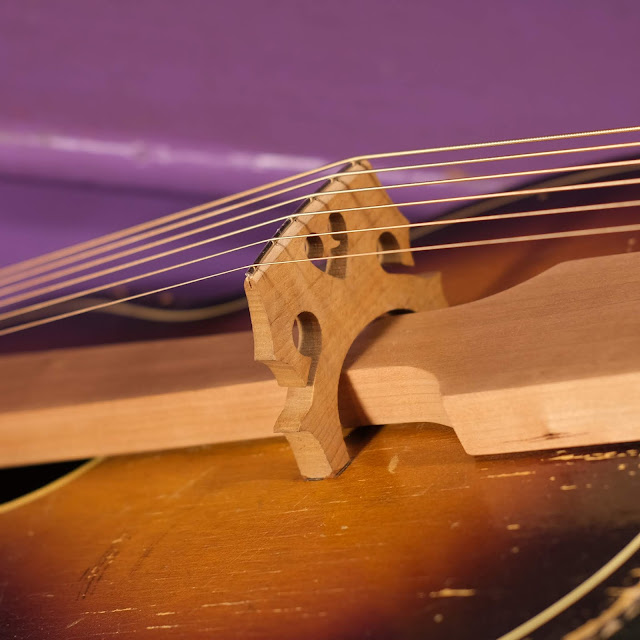1950s/2019 United/Wildwood Guitar-Koto
My buddy Steve asked me to make a couple of "passerelle bridges" of the type that Kaki King uses to turn her guitars into koto-like instruments, and maybe to modify some guitar hanging-about to function that way. I digested that information and said that I'd be happy to do that but that I'd also be making an instrument built more for that purpose.
The fundamental problem of the "add the bridge to any guitar" device is that it doesn't put the bridge in a very functional place on the soundboard (as it's located at the 16th fret and thus above the soundhole) -- so instead of receiving input from both sides of the koto-like strings (you play on either side of the bridge on these), the soundboard's really only receiving the short side of the playing strings and then whatever random transmission of sound from the long side that manages to get through.
The "passerelle" bridge chops the original guitar scale length into two sections (effectively about 15 3/8" and 9 1/4" on something like a 25 1/2" Fender) and raises the strings so the frets are useless and you're playing something more akin to a harp. On the "long side" of the split strings you have a root note and on the "short side" you have a perfect fifth. So if you were tuned to C on the long side you'll get a G on the short side.
Immediately, I saw this as a problem applied to a guitar-sized instrument, though. The chopped "scales" are very short. For this project I decided to lengthen the "overall" string length to 32" and thus got a 19 5/16" long side and 12 3/4" short side. At those lengths, notes approaching the low E of a guitar sound OK from the long side of the strings.
To rectify the problem of the bridge being in the wrong place, I used a spare 1950s parlor body (United-made in New Jersey) and fashioned a neck to bolt onto the top of it from a spare cherry board I had in my wood stash. The bridge is a cut-down old cello bridge with a fret saddle on top. This new neck simply bolts (with a few spacers to keep it from damping the top) to the endblock and neckblock and the body has been "reversed" as-normal so the bridge sits in the right spot. The guitar-koto can still hang by the headstock on a guitar hanger or sit in a guitar stand like a normal instrument.
The end product handles nicely and has about the same volume you'd expect from a normal, el-cheapo, small-body guitar. It sounds lovely when you apply koto-like playing effects and styles to it, of course. My brain is still doing a lot of remapping to figure-out this instrument and how to play it effectively, but after this goes home to its owner I'm definitely thinking of making my own purely-from-scratch instrument along similar lines.
It's tuned in a minor pentatonic scale -- on the long-string side that's F, G#, Bb, C, Eb, F low to high and then a fifth above that on the short-string side. I'm using gauges 56w, 48w, 40w, 36w, 28w, 22w. Of course you can bend the strings on either side to get all the in-between notes, too, though the fun of this is to just pick around and get lost in the harp-like drone.
In the pictures, you can see a couple of white dots in the "fingerboard" areas that mark the octave harmonic position. Since then I've added a few more dots on either side to mark other harmonic positions.
Long side scale: 19 5/16"
Short side scale: 12 3/4"
Overall scale: ~32 1/4"
The headstock lost its purity-of-looks when I realized I needed to add some extra downpressure on the strings. Oops...! Note how I've dished-out the nut slots so that the strings only make contact with the nut in a short amount of space. This has been useful to keep chatter/unwanted resonances down.
Gotoh-made Kluson-style tuners are nice to have.














Comments